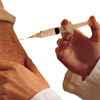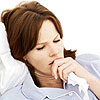- Cold and flu prevention tips
- Limit exposure to cold and flu viruses
- Practise healthy habits to prevent cold and flu
- Influenza vaccination
Cold and flu prevention tips
Colds and flus cause considerable illness, negatively affect our social life and cost us a lot of money in medical bills and time off work. Every year the average adult catches a common cold 2-4 times and children experience 6-8 colds. A cold typically lasts for 7-10 days, which adds up to a lot of time off work, in bed and feeling unwell. Influenza is less common, but more serious than a cold. Yet, up to one in five Australians catch the flu each winter and children are more than twice as likely to get the flu.
As there are no cures for common colds or the flu, prevention is the best strategy for minimising the disruptions to work and social life. There are many things you can do to reduce your chance of being exposed to these viruses. If you are exposed, you can still reduce the likelihood you’ll become infected and ill.
More people catch a common cold or the flu in winter months because of weather changes and they spend more time indoors where the viruses that cause these illnesses can spread easily.
You need to be especially careful about hygiene in cold and flu season, because when someone catches a cold or flu, they are contagious and can start spreading the virus causing their illness for about 24 before they start having symptoms which make them feel unwell.
Limit exposure to cold and flu viruses
1. Wash your hands
Maintaining good hand hygiene is vital during the cold and flu season. Colds and flus can be spread via aerosol droplets from coughing and sneezing, and by touching surfaces that infected individuals may have been in contact with. The virus commonly enters your body when you touch your nose, mouth or eyes with infected hands.
It is best to make a habit of washing hands for at least 10-15 seconds in warm soapy water, especially after coughing or sneezing and before eating. Teach children to wash their hands as well. If you do not have access to water, you can use an alcohol-based disinfectant hand gel with at least 60% alcohol content.
2. Avoid crowds and sick people
Sometimes it is difficult to identify sick people, as people who are infectious may not have any symptoms in the early stages of their illness. Try to avoid people who you know have a cold or flu, and stay away from crowded areas during flu season to reduce your chance of infection. This is particularly important for babies in the first few months of life.
3. Disinfect surfaces
Keep household surfaces clean (e.g. door knobs, switches and telephones) as they can harbour viruses for several hours. Wipe and disinfect these surfaces regularly. Individuals should use separate towels or paper towels in kitchens and bathrooms, especially for those who have a cold or flu. Throw tissues out immediately after use as they can spread the virus to surfaces.
4. Stay warm and dry
Staying warm and dry won’t prevent colds and flus which are caused by viruses. But when you are infected with a cold or flu virus, staying warm and dry might reduce the likelihood you’ll be affected by symptoms like coughing and sneezing. This occurs because getting cold causes the blood vessels in the nose to narrow, and when less blood is flowing in and out of the nose, cold and flu virus find it easier to multiply.
Practise healthy habits to prevent cold and flu
If you are healthy, your immune system is stronger and better able to fight infection. You can enhance your body’s natural resistance mechanisms by eating well, remaining physically active despite the cold weather, and getting enough sleep.
1. Boost the immune system to beat colds and flus
Healthy eating
Eating a balanced diet provides your body with the nutrients and vitamins it needs to help the immune system fight infection. Eat foods containing phytochemicals such as dark green, red and yellow fruit and vegetables. Eating a colourful diet (yellow, orange, purple, red and green vegetables) is a good way to ensure your diet includes all the micronutrients your immune system needs.
Foods containing healthy oils like salmon, kefir, tuna, flaxseeds and walnuts are also great for the immune system, as are Vitamin C rich food like oranges and tomatoes. Vitamin E and Selenium are two other immune boosting micronutrients you should include in your diet. Broccoli, brussel sprouts and almonds are all good sources of vitamin E and meat and poultry are rich in selenium. Eating a tub of yoghurt daily can reduce the chance of catching a cold by 25%.
Other healthy eating habits which can boost the immune system include:
- Eat a healthy breakfast everyday;
- Grill, steam or bake foods instead of frying;
- Eat sugary foods in moderation;
- Limit alcohol consumption;
- Eat plenty of fruits and vegetables.
If you need to improve your diet, try to make changes gradually, for example by adding one healthy habit per day.
Rest
Getting plenty of sleep also helps boost the functioning of your immune system. You should aim to get at least 7-8 hours of sleep a night. People who sleep less than 7 hours a night are nearly 3 times more likely to catch a cold than those getting more than 8 hours a night. Just resting and relaxing is also important.
Herbal remedies
Contrary to popular belief, herbal remedies like Vitamin C, echinacea and zinc do not prevent colds.
2. Reduce stress
People who are under stress tend to have weakened immune systems, so are more likely to get sick and experience more severe symptoms.
People who are more sociable are less likely to get sick. Researchers believe this is because people who have more social contacts and support are less likely to feel stressed than people who keep to themselves. So if you are run down or stressed, try to incorporate some relaxation techniques into your life. If you remain relaxed, your immune system produces more of the chemicals needed to fight infection (interleukins).
3. Stop smoking
Smokers are more prone to respiratory illness than non-smokers, and experience more severe and frequent colds. This is because cigarette smoke dries out nasal passages and paralyses the hairs that line the mucous membranes, which normally act to sweep viruses out of the nasal passages. Non-smokers should take care to avoid second-hand smoke.
 |
To learn more about the negative effects of smoking on your health, see Smoking. |
4. Exercise regularly
Regular exercise, particularly cardiovascular exercise, helps keeps you fit and gives your immune system a boost, enabling it to function more effectively. Exercise can increase the number of virus-killing cells in your body. It may not prevent all infections, but it can speed up recovery and reduce the intensity of symptoms. Exercise also helps you distress which is an important part of staying healthy.
5. Regulate humidity
Other ways to avoid catching a cold are to ensure your house is not overheated, and to increase the humidity by using cool mist humidifiers or vaporisers. The low humidity created by heating dries out the mucous membranes of the nasal passages, making you more vulnerable to infection. Low humidity also provides an environment that encourages viruses to survive and thrive. Make sure you go out and get fresh air to counteract the drying effects of indoor heating.
Influenza vaccination
The flu vaccine provides one of the best ways to protect against the flu and is particularly important for people who are at high risk of developing flu-related complications (e.g. infants, pregnant women, people over 65, or people with chronic health conditions such as asthma, diabetes or heart disease). The large number of viruses capable of causing colds means that there are no vaccines for the common cold. Vaccines only protect against a single virus, however there are more than 200 viruses which can cause colds. However, there are flu vaccines available including Agrippal (inactivated influenza vaccine), Fluarix (inactivated influenza vaccine), Influvac (inactivated influenza vaccine), Vaxigrip (inactivated influenza vaccine) Fluvax (inactivated influenza vaccine) and Intanza (inactivated influenza vaccine).
The flu vaccine is between 70-90% effective, depending on the intensity and length of the flu season. In Australia, the flu season begins around May and continues until September (Autumn and winter). The flu vaccine is best administered in March/April (or even as early as February) to provide full protection.
 |
For more information, see Influenza Vaccine
. |
Most people are able to obtain a flu shot. There are certain groups of people who are highly susceptible to complications and are therefore strongly advised to get vaccinated. In Australia, the flu vaccine is free of charge for people aged over 65, and for Aboriginal and Torres Strait Islanders (ATSIs) aged over 50 years or aged 15-49 years with a chronic illness.
New vaccines are produced every year and supplies are sometimes limited. If you need a flu shot it is a good idea to talk to your doctor early to make sure you can get vaccinated before the flu season starts.
In Australia, immunisation is recommended for:
- All adults aged over 65 years;
- Infants and children aged from 6 months to 4 years;
- Children on long term aspirin therapy;
- Pregnant women (especially those who are in their second or third trimester between June and October);
- Anyone with a chronic medical condition (e.g. asthma, diabetes or heart, kidney or lung disease);
- Anyone with a weakened immune system or who is undergoing immunosuppressive treatments;
- Residents of nursing homes or long term care facilities;
- Child care workers, health care workers, or anyone living with or looking after someone at high risk of developing flu-related complications; and
- Anyone visiting parts of the world where influenza is circulating.
- People who have had an allergic reaction to a flu vaccine in the past;
- People with allergies to chicken eggs (the vaccine is cultivated in chicken eggs);
- Anyone who has developed Guillain-Barre syndrome within six weeks of receiving the vaccine in the past;
- Children under 6 months of age; and
- People suffering from an illness with a fever.
More information
 |
For more information on the common cold and influenza, types of influenza and treatments and tips for preventing influenza, see Cold and Flu. |
References
- Meadows M. Beat the winter bugs: How to hold your own against colds and flu. FDA Consumer. 2001; 35(6):11-18. [Citation]
- Covington TR, Henkin R, Miller S, Sassetti M, Wright W. Treating the common cold: An expert panel consensus recommendation for primary care clinicians. Guidelines. 2004; 5(4): 1-16 [online]. Illinois Academy of Family Physicians. October 2004 [cited 14 April 2013]. Available from: [URL Link]
- Heikkinen T, Järvinen A. The common cold. Lancet. 2003; 361(9351): 51-9. [Abstract]
- Centres for Disease Prevention and Control. Cold versus Flu. 2011. [cited 13 April 2013]. Available from: [URL Link]
- Department of Health and Ageing. Influenza. Australian Immunisation Handbook. 10th Ed. 2013. [cited 23 May 2013]. Available from: [URL Link]
- Centres for Disease Control and Prevention. Everyday preventive actions that can help fight germs, like flu. 2013. [cited 17 May 2013]. Available from: [URL Link]
- National Health Service. Preventing Colds and Flus. 2012. [cited May 17 2013]. Available from: [URL Link]
- Aggripal Consumer Medical Information [online]. North Ryde, NSW. Novartis Vaccines and Diagnostics. April 2013. [cited May 17 2013] [URL Link].
- Fluarix- Consumer Medical Information [online]. Abbotsford, Vic. Glaxosmithkline Australia Pty Ltd. [cited 17 May 2013]. November 2012. Available from: [URL Link]
- Influvac- Product Information [online]. Botany NSW. Abbott Australiasia Pty Ltd. November 2012. [cited 17 May 2013]. Available from: [URL Link]
- Vaxigrip Product Information [online]. Macquarie Park, NSW. Sanofi-Aventis Australia Pty Ltd. November 2012. [cited 17 May 2013]. Available from: [URL Link]
- Fluvax Consumer Medical Information [online]. Parkville, Vic. October 2012 [cited 17 May 2013]. Available from: [URL link]
- Intanza Product Information [online]. Macquarie Park, Vic. Sanofi-Aventis Australia Pty Ltd. November 2012. [cited 17 May 2013]. Available from: [URL Link]
- Logan T. Healthy eating tips for cold and flu season. Davidson College. 2008. [cited 31 May 2013]. Available from: [URL Link]
- South Australian Government. Colds and Flus- wash, wipe, cover- don’t infect another. 2008. [cited 13 April 2013]. Available from: [URL Link]
- Centers for Disease Control. Seasonal flu: Good health habits for prevention [online]. 6 October 2006 [cited 6 June 2011]. Available from: [URL Link]
- Mayo Clinic. Flu shot: Your best shot for avoiding influenza [online]. 9 April 2008 [cited 6 June 2011]. Available from: [URL Link]
- Centres for disease control and prevention. Preventing the flu- good health habits can help stop germs. 2013. [cited 14 April 2013]. Available from: [URL Link]
- Dickenstein JB, Moldofsky H. Sleep, cytokines and immune function. Sleep Med Rev. 1999; 3(3): 219-28. [Abstract]
- Cohen S, Tyrrell DA, Russell MA, et al. Smoking, alcohol consumption, and susceptibility to the common cold. Am J Public Health. 1993;83(9):1277-83. [Abstract]
- South Australia Department of Health. Flu vaccine Frequently Asked Questions. 2011. [cited June 6 2011]. Available from: [URL Link]
- The Australian Immunisation Handbook (9th edition) [online]. Canberra, ACT: Australian Government Department of Health and Ageing; 2008 [cited 14 April 2013]. Available from: [URL link]
- Department of Health and Ageing. Influenza. 2013. [cited May 3, 21013]. Available from: [URL Link]
- Olszewska W, Zambon M, Openshaw PJ. Development of vaccines against common colds. Br Med Bul. 2002; 62(1): 99111. [Full Text]
- Walsh NP, Gleeson M, Shepard RJ, et al. Position Statement- Part 1- Exercise and immune function. Exer Immunol Rev. 2011; 17: 6-63. [Abstract]
- National Institute of Allergy and Infectious Disease. Common Cold. 2011. [cited 3 May 2013] Available from: [URL Link]
- Centres for Disease Control and Prevention. Key facts about seasonal influenza- flu vaccination. 2013. [cited 31 May 2013]. Available from : [URL Link]
- Schiffert Health Centre. Common Cold and the College Student. 2010. [cited 16 June 2013]. Available from: [URL Link]
All content and media on the HealthEngine Blog is created and published online for informational purposes only. It is not intended to be a substitute for professional medical advice and should not be relied on as health or personal advice. Always seek the guidance of your doctor or other qualified health professional with any questions you may have regarding your health or a medical condition. Never disregard the advice of a medical professional, or delay in seeking it because of something you have read on this Website. If you think you may have a medical emergency, call your doctor, go to the nearest hospital emergency department, or call the emergency services immediately.










